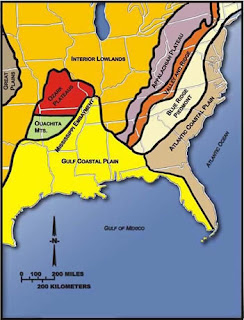While Alabama is located in the Southern region, Mobile (pronounced moh-BEEL), because of its proximity to the Gulf Coast, is located in the Southern Coastlands region. Mobile is often referred to as the City of Six Flags, as the French, British, Spanish, US, Confederate and Alabama flags have all been flown here. Because several rivers converge in the city to release into the Gulf of Mexico, Mobile, is the only port city in Alabama. Its location at the juncture of the Mobile River and Mobile Bay on the northern Gulf of Mexico has played a vital role in the economic health of the city, beginning as a key trading center between the French and Native Americans. It is now the 9th largest port in the United States. This proximity to tributaries and waterways also serves to make Mobile one of the most humid cities in the country and also makes Mobile one of the wettest cities with more than 5 feet of precipitation a year.
 |
| Mobile Bay |
The economy of Mobile is centered around aerospace, retail, construction, medicine and manufacturing. Being a port city, the Alabama State Docks and Austal USA, a production facility for US defense and commercial aluminum shipbuilding provide much of the city’s income. Bayou La Batre, a coastal community figured in to Mobile County, offers, counts seafood as its major industry and is the “Seafood Capital of Alabama,” processing seafood - mostly shrimp, crabs, and oysters - from the Gulf as well as from other states.
 |
| West Indies Salad |
 |
| Gumbo |
Mobile has a population of 193,171. Demographic statistics show that 48.9% African-American, 45.9% Caucasian, 2% Asian and 3.2% Other make up this population. Because of the various national flags that have flown in Mobile, its culture is rich with French and Spanish influences that can be seen from the annual celebration of Mardi Gras - yes, Mobile is the home of Mardi Gras and we had it before New Orleans! - to the delicious food you can find in any mom-and-pop restaurant or Southern home, and the architecture of the buildings on Dauphin St. downtown and the antebellum homes that line Government St.
Sources:























